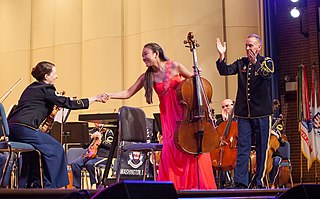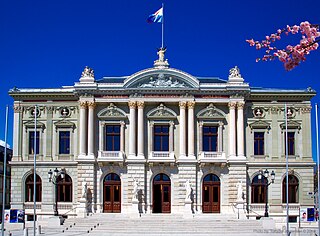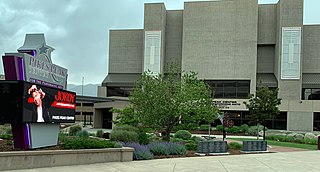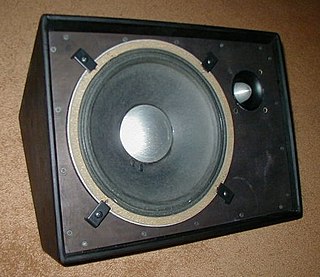
An orchestra is a large instrumental ensemble typical of classical music, which combines instruments from different families. There are typically four main sections of instruments:

A proscenium is the metaphorical vertical plane of space in a theatre, usually surrounded on the top and sides by a physical proscenium arch and on the bottom by the stage floor itself, which serves as the frame into which the audience observes from a more or less unified angle the events taking place upon the stage during a theatrical performance. The concept of the fourth wall of the theatre stage space that faces the audience is essentially the same.

The Bayreuth Festspielhaus or Bayreuth Festival Theatre is an opera house north of Bayreuth, Germany, built by the 19th-century German composer Richard Wagner and dedicated solely to the performance of his stage works. It is the venue for the annual Bayreuth Festival, for which it was specifically conceived and built. Its official name is Richard-Wagner-Festspielhaus. It is the home of the Bayreuth Festival Orchestra.

An auditorium is a room built to enable an audience to hear and watch performances. For movie theatres, the number of auditoria is expressed as the number of screens. Auditoria can be found in entertainment venues, community halls, and theaters, and may be used for rehearsal, presentation, performing arts productions, or as a learning space.

The concertmaster, first chair (U.S.) or leader (U.K.) is the principal first violin player in an orchestra. After the conductor, the concertmaster is the second-most significant leader in an orchestra, symphonic band or other musical ensemble.

A pit orchestra is a type of orchestra that accompanies performers in musicals, operas, ballets, and other shows involving music. The term was also used for orchestras accompanying silent movies when more than a piano was used. In performances of operas and ballets, the pit orchestra is typically similar in size to a symphony orchestra, though it may contain smaller string and brass sections, depending upon the piece. Such orchestras may vary in size from approximately 30 musicians to as many as 90–100 musicians. However, because of financial, spatial, and volume concerns, current musical theatre pit orchestras are considerably smaller.

In theatre and performing arts, the stage is a designated space for the performance of productions. The stage serves as a space for actors or performers and a focal point for the audience. As an architectural feature, the stage may consist of a platform or series of platforms. In some cases, these may be temporary or adjustable but in theaters and other buildings devoted to such productions, the stage is often a permanent feature.

A theater, or playhouse, is a structure where theatrical works, performing arts, and musical concerts are presented. The theater building serves to define the performance and audience spaces. The facility usually is organized to provide support areas for performers, the technical crew and the audience members, as well as the stage where the performance takes place.

A rehearsal is an activity in the performing arts that occurs as preparation for a performance in music, theatre, dance and related arts, such as opera, musical theatre and film production. It is undertaken as a form of practising, to ensure that all details of the subsequent performance are adequately prepared and coordinated. The term rehearsal typically refers to ensemble activities undertaken by a group of people. For example, when a musician is preparing a piano concerto in their music studio, this is called practising, but when they practice it with an orchestra, this is called a rehearsal. The music rehearsal takes place in a music rehearsal space.
The RiverCenter for the Performing Arts is a modern performance space in Downtown Columbus, Georgia, United States.

The Krannert Center for the Performing Arts is an educational and performing arts complex located at 500 South Goodwin Avenue in Urbana, Illinois and on the campus of the University of Illinois Urbana-Champaign. Herman C. Krannert, an industrialist who founded Inland Container Corporation and an alumnus of the university, and his wife, Ellnora Krannert, made a gift of $16 million that led to the Krannert Center's construction. Max Abramovitz, the architect who designed the facility, was also an Illinois alumnus.

Grand Théâtre de Genève is an opera house in Geneva, Switzerland.
Orchestral enhancement is the technique of using orchestration techniques, architectural modifications, or electronic technologies to modify the sound, complexity, or color of a musical theatre, ballet or opera pit orchestra. Orchestral enhancements are used both to create new sounds and to add capabilities to existing orchestral ensembles.

The Pikes Peak Center for the Performing Arts is a concert auditorium in Colorado Springs, Colorado. It serves as an entertainment, cultural, educational, and assembly center for the citizens of El Paso County, the Pikes Peak region, and the surrounding area.

A music stand is a pedestal or elevated rack designed to hold sheets of music in position for reading. Most music stands for orchestral, chamber music or solo orchestra-family instruments can be raised or lowered to accommodate seated or standing performers, or performers of different heights. Many types of keyboard instruments have a built-in or removable music rack or stand where sheet music can be placed. Music stands enable musicians to read sheet music or scores while playing an instrument or conducting, as the stand leaves the hands free. For choirs, singers typically hold their music in a folder, and singers performing solo recitals or opera performances typically memorize the lyrics and melodies. Some singers use stands, such as lounge singers and wedding vocalists who have a repertoire of hundreds of songs, which makes remembering all of the verses difficult.

The string section is composed of bowed instruments belonging to the violin family. It normally consists of first and second violins, violas, cellos, and double basses. It is the most numerous group in the standard orchestra. In discussions of the instrumentation of a musical work, the phrase "the strings" or "and strings" is used to indicate a string section as just defined. An orchestra consisting solely of a string section is called a string orchestra. Smaller string sections are sometimes used in jazz, pop, and rock music and in the pit orchestras of musical theatre.
There are different types of theatres, but they all have three major parts in common. Theatres are divided into two main sections, the house and the stage; there is also a backstage area in many theatres. The house is the seating area for guests watching a performance and the stage is where the actual performance is given. The backstage area is usually restricted to people who are producing or in the performance.

A stage monitor system is a set of performer-facing loudspeakers called monitor speakers, stage monitors, floor monitors, wedges, or foldbacks on stage during live music performances in which a sound reinforcement system is used to amplify a performance for the audience. The monitor system allows musicians to hear themselves and fellow band members clearly.

The Mount Baker Theatre is a 1,517-seat performing arts venue and national historic landmark in Bellingham, Washington, United States. The theater hosts professional productions and concerts as well as community performances from the north of Puget Sound. The theater's main stage is the largest theatrical venue in Washington north of Seattle's Paramount and 5th Avenue.

Offstage musicians and singers are performers who play instruments and/or sing backstage, out of sight of the audience, during a live popular music concert at which the main band is visible playing and singing onstage. The sound from the offstage musicians or singers is captured by a microphone or from the output of their instrument, and this signal is mixed in with the singing and playing of the onstage performers using an audio console and a sound reinforcement system. Offstage backup singers are also used in some Broadway musicals, as have offstage instrumentalists, in cases where an onstage actor needs to appear to play an instrument.


















